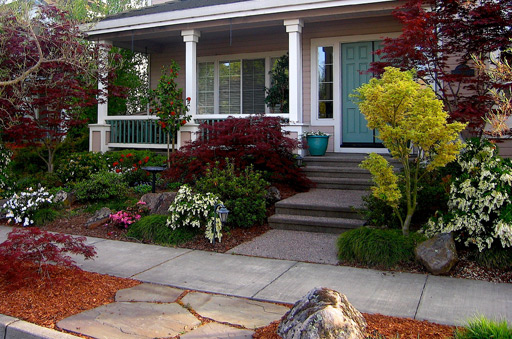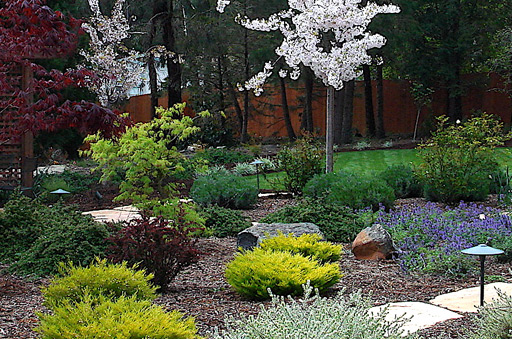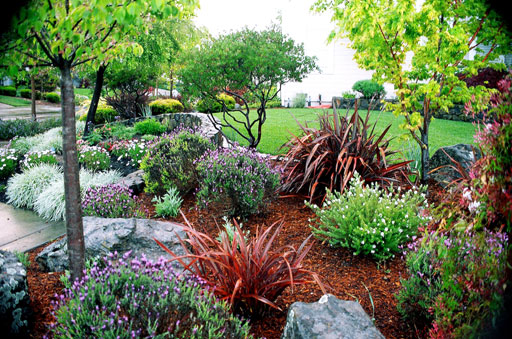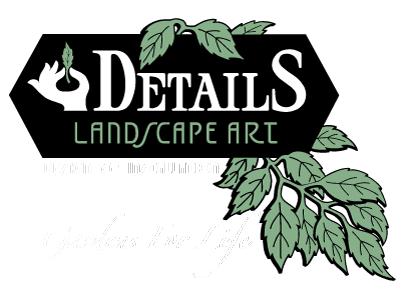The patio, walkways, masonry and water features are in place or at least designed. It’s time to ‘flesh out’ the garden with trees, plants, placement boulders and garden art. But before we start, there are relevant garden design issues to be addressed.
In recent years we have seen a heightened awareness about conservation and sustaining the environment. More immediate concerns about drought, water rationing, and the expense of garden maintenance have made us rethink how we build gardens in today’s climate and economy.
Scott Bradley, owner of Details Landscape Art, has been designing and installing fine gardens throughout the North Bay since 1991. “People are always asking us for low maintenance yards”, says Scott. “Can you guess what the highest maintenance plant is? Grass. It is thirsty, and needs regular watering, mowing, weeding, feeding, and edging. In addition, it is seriously uninteresting. Details Landscape Art encourages water conservation, and recommends small lawns or no lawns. The resulting gardens are more visually appealing and more water efficient. The plants are irrigated by a drip system and programmed by controllers that regulate the duration and frequency of water application.”

That having been said, minimizing lawn size, yields larger plant gardens, and the need for intelligent design is critical. Scott has a great eye for color, texture and style. “Plant selection and placement is definitely an art form.” Several simple garden design techniques will ensure an interesting and visually appealing garden all year long.
 First is the concept of color. The most common way of achieving color in the garden is with flowers. Flowering trees and shrubs, perennials and annuals all yield colorful blooms. However, there is the second concept or consideration, which is maintenance. Annuals require replacement every few months. Perennials require deadheading from time to time depending on the particular plant. Homeowners may or may not enjoy gardening. If they see gardening as a chore rather than a hobby, then flowering annuals and perennials may not be their cup of tea. So in that case, one of our landscape sign techniques is using color in the foliage. There are a myriad of shrubs and trees with burgundy, gold and silver green foliage. Combinations of these colors are relatively maintenance free and colorful.
First is the concept of color. The most common way of achieving color in the garden is with flowers. Flowering trees and shrubs, perennials and annuals all yield colorful blooms. However, there is the second concept or consideration, which is maintenance. Annuals require replacement every few months. Perennials require deadheading from time to time depending on the particular plant. Homeowners may or may not enjoy gardening. If they see gardening as a chore rather than a hobby, then flowering annuals and perennials may not be their cup of tea. So in that case, one of our landscape sign techniques is using color in the foliage. There are a myriad of shrubs and trees with burgundy, gold and silver green foliage. Combinations of these colors are relatively maintenance free and colorful.
Our garden design style is to mix heights, textures and bloom seasons, and to include both deciduous and evergreen plant material. If all plants in the garden are the same height, nothing stands out. Tall, short, medium and flat ground covers results in a visually interesting palette. Mixing textures – soft grasses, spiky phormiums, chunky shrubs of different height in addition to boulders and maybe some wood elements also add to the visual interest. Then who wants a showy garden in summer followed by no blooms at all in the fall? Gardens can be beautiful all year long. When one plant stops blooming another can begin the flower show. And colorful foliage can be year round also. A garden with all evergreens is boring – no spring blooms, no fall color. A garden with all deciduous plants and trees means a totally bare garden in the winter. A blend of both evergreen and deciduous is ideal/
Good garden design creatively blends all the above techniques.

